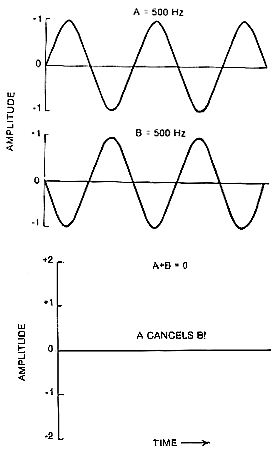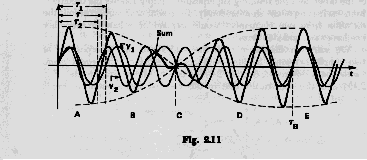
Superimposition of two sine tones of equal frequency and equal phase.
The superimposition of two sine tones of equal frequency and equal phase results in a sine tone of the same frequency and the same phase, but whose amplitude is the sum of the amplitudes of the two component vibrations.
If the two component vibrations have different phases, their superimposition is still a sine tone of the same frequency, but the amplitude will be the sum of their amplitudes in time. In particular, if the phase difference is 180deg. both oscillations will annihilate each other and no sound will be heard. This is called destructive interference and plays a role in room acoustics.

Superimposition of two sine tones (y1 and y2 ) of equal amplitude with slightly different frequencies.
freq y1 = f1 freq y2 = f2
Assume f2 = f1 + ![]() f
such that the frequency difference
f
such that the frequency difference ![]() f has a small absolute value.
f has a small absolute value.
The vibration pattern of the eardrum is still the same as before, namely the sum of the pattern of each component tone.

Note: 1. The slowly changing phase difference between the component tones y1 and y2. They start in phase (0deg. phase difference) at the instant t=0, then y2 starts leading y1 in phase, until both are completely out of phase (180deg. phase difference). The phase difference keeps increasing until it reaches 360deg. = 0deg. at instant tB.
2. This continuous slow phase shift is responsible for the changing amplitude of the resultant oscillation which is represented by the broken line curves.